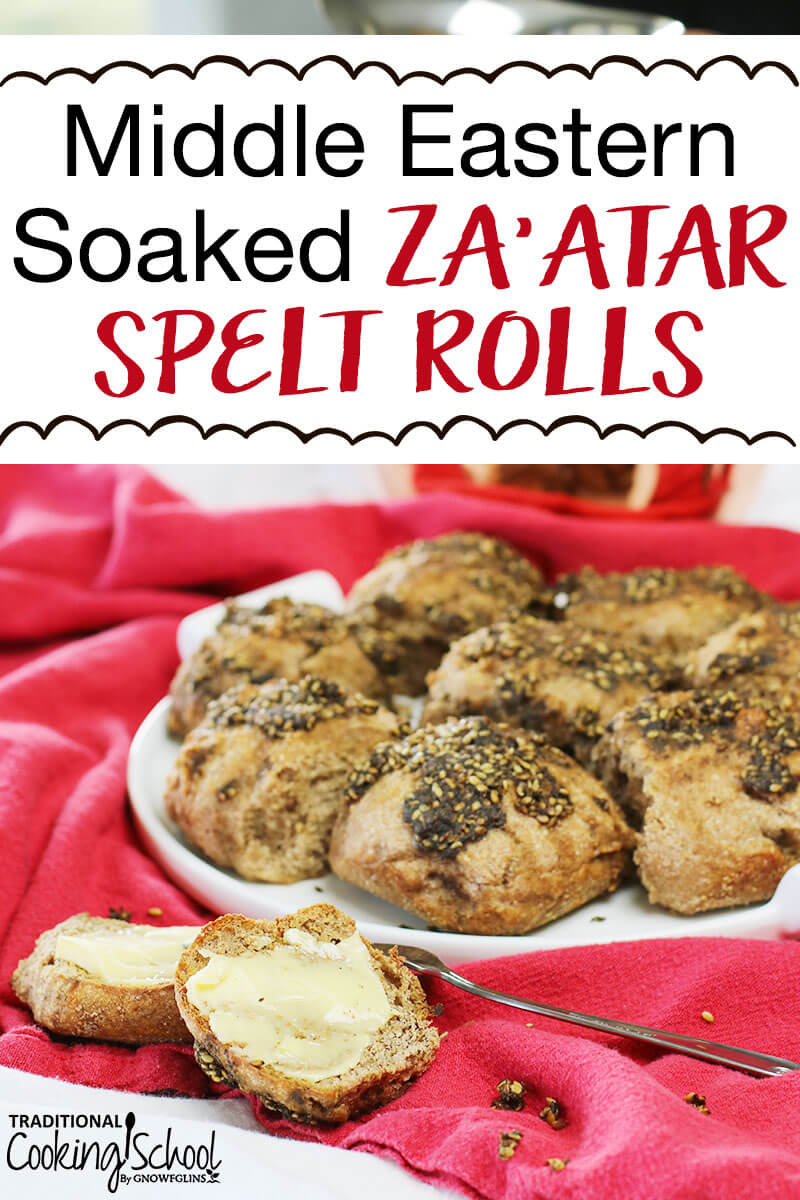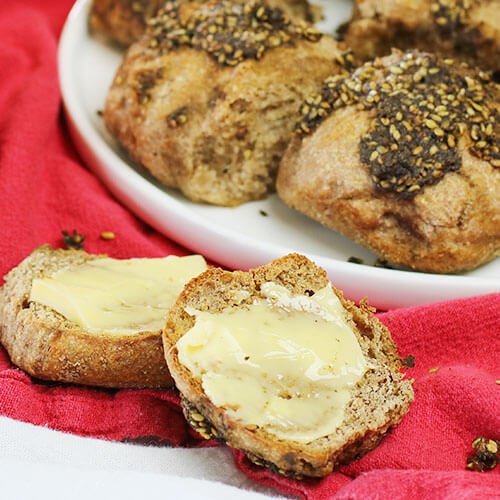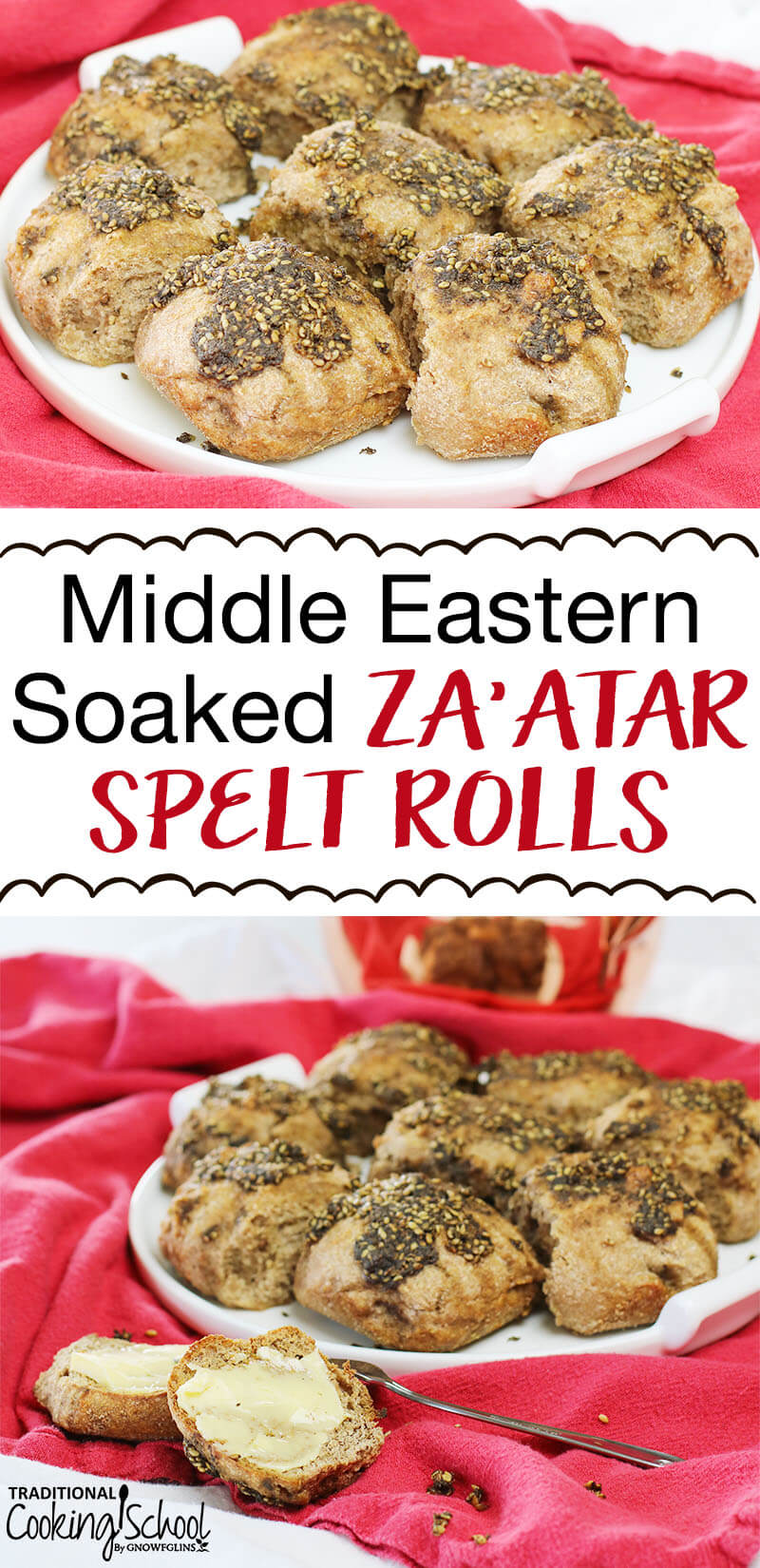
There are many things to be thankful for in this life…
And za’atar is one of them!
This spice blend is a staple of traditional Middle Eastern cooking. Back then (and probably now, too), every family had their own secret special recipe for it. My Tata (Arabic for “grandma”) keeps an eye out for truly good za’atar at ethnic markets when she travels.
…which is how I came to love it so much! She brought me a huge jar of za’atar last time she visited, and I’ve been liberally sprinkling it on meat, eggs, veggies, hummus, and bread ever since.
These rolls are inspired by manakish — traditional Palestinian flatbread slathered in olive oil and za’atar spice blend. Instead of flatbread, I’ve chosen to use soaked spelt rolls as the vehicle for my za’atar obsession. 😉 There’s really no way to compete with tender za’atar-brushed spelt rolls, toasted with a pat of butter. I especially enjoy mine with eggs in the morning!
If you’ve never indulged in Middle Eastern food before, you’re in for a treat!

Middle Eastern Soaked Za'atar Spelt Rolls
Inspired by traditional Palestinian flatbread manakish, these soaked spelt rolls are slathered in olive oil and za'atar spice blend -- a staple of Middle Eastern cuisine! There's just no way to compete with homemade dinner rolls (soft and fluffy!) and one of the best spice mixes on the planet. Enjoy these easy rolls with a pat of butter or dollop of hummus, no bread machine required!
Ingredients
- 3-1/4 cups spelt flour 390 g
- 1/2 cup kefir or yogurt 125 g
- 3/4 teaspoon sea salt 5 g
- 3/4 cup pure water 190 g
- 1/2 tablespoon SAF instant yeast 4 g
- 2 tablespoons extra virgin olive oil
- 3-2/3 tablespoons za'atar
Instructions
The evening before...
-
In a medium-sized bowl, combine all ingredients in order listed, except the olive oil and za'atar.
-
Mix together, using clean hands, until a smooth soft ball of dough forms.
-
Cover with a plate and let sit in a warm place for 6 to 8 hours, or overnight.
The morning of...
-
Preheat oven to 400 degrees Fahrenheit.
-
Grease and flour an 8x8" baking pan.
-
Pull the dough away from the sides of its bowl, shaping it for just a few seconds until it is a smooth ball.
-
Separate dough into thirds, then each of the three pieces again into thirds.
-
Gently shape each piece into a ball, then place in baking pan. Repeat with the rest of the dough.
-
Place rolls in preheated oven for 15 minutes.
-
Meanwhile, combine olive oil and za'atar spice blend in a small bowl.
-
After 15 minutes, remove rolls from oven and gently brush with spice and oil mixture.
-
Place rolls back in oven for an additional 15 minutes.
-
Once baked, remove from oven and let cool. Cut rolls in half and slather generously with butter. Enjoy!
Recipe Notes
I know what many of you might be thinking... Why use yeast in these rolls? Yeast allows these tender spelt rolls to be fluffy and soft, whereas the overnight soaking step makes them digestible. So there's no need to worry! We're using yeast as a leavening agent, like we would baking soda, but fermentation is still happening so sensitive tummies can enjoy these spelt rolls.
Looking for other Middle Eastern recipes?
- Middle Eastern Shepherd’s Pie With Lamb (Kibbit Batata)
- Middle Eastern Apricot Mousse With Nut Crumble Layers (Mish Mish)
- Homemade Sourdough Mediterranean Pizza (with ancient wheat einkorn!)
- Mediterranean Stuffed Grape Leaves {Dolmas}
How will you enjoy these soaked spelt rolls? Have you ever tried za’atar before?
...without giving up the foods you love or spending all day in the kitchen!

2 free books:
Eat God's Way
Ditch the Standard American Diet, get healthier & happier, and save money on groceries...
We only recommend products and services we wholeheartedly endorse. This post may contain special links through which we earn a small commission if you make a purchase (though your price is the same).



Oh Haniya, i love your soaked spelt adaptation of manakish pizzas! Can’t wait to try them myself. We make always them when we’re making a big batch of khobez arabi, but this way it’s so much easier to have more frequently. Thank you!
I’m so happy you enjoy the za’ater. I have some more for you!
Love, Tata Martha
Aloha Haniya~
I just read about your eye sensitivity to castor oil. I’ve been using castor oil personally & professionally on humans, animals & plants for 50 years now, for every purpose under the sun, both internally (except not ingesting it) & externally. I can say that if you have a sensitivity to cold pressed organic or cold pressed commercial grade castor oil, whether it is applied to your skin or eyes, it is pulling out something that should not be in your system. Otherwise, it is a very soothing oil & in 50 years of use on myself & others, only when there was hidden infection (one time only), did big red pus filled bumps appear. It was behind each ear. We washed the affected area with warm soapy lather 3 times that day & rinsed it very well & patted it dry. Then we reapplied the castor oil to allow it to continue drawing out the infection. The next day it was much better & on the 3rd day all traces of infection were gone. The reason we applied the oil in the first place was because of a feeling of tenderness. This patient was confined to bed.
I’m sharing information to help people learn how to heal difficult/hidden/untreatable infections, illnesses & diseases because sometimes hidden conditions can be discovered when a paricular method of cleaning the body is used. Just in case you’d like to explore how to safely & gently clean your eyes (I did this the other day & no longer have any itching, redness or morning stuff in my eyes), look for the book MMS Health Recovery Guidebook by author Jim Humble with Cari Lloyd.
Mahalo for your wonderful writing & contributions.
Thank you for the recipe. Can fresh yeast alone be used during soaking if left for 8-24 hours? Will it have an effect on phytic acid, please? Thank you!